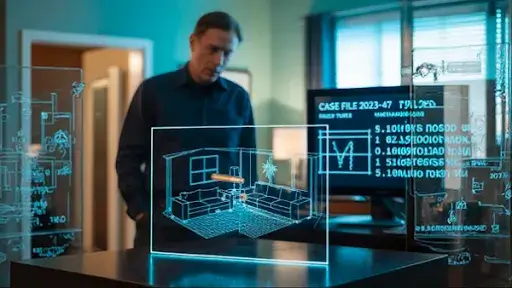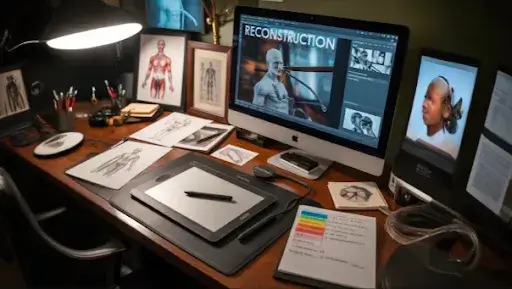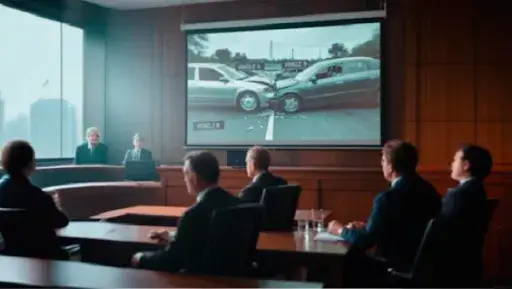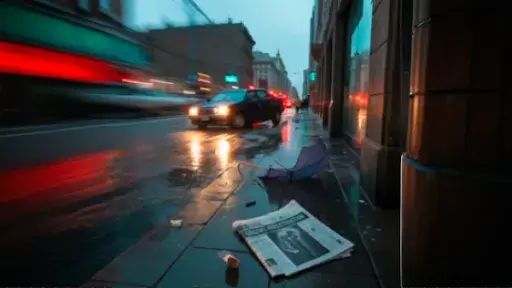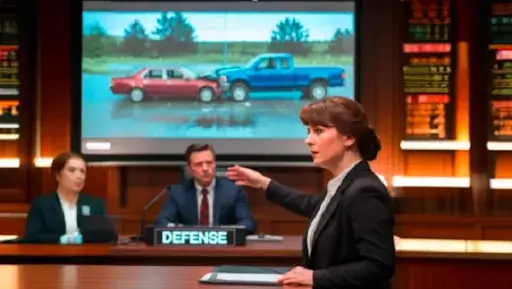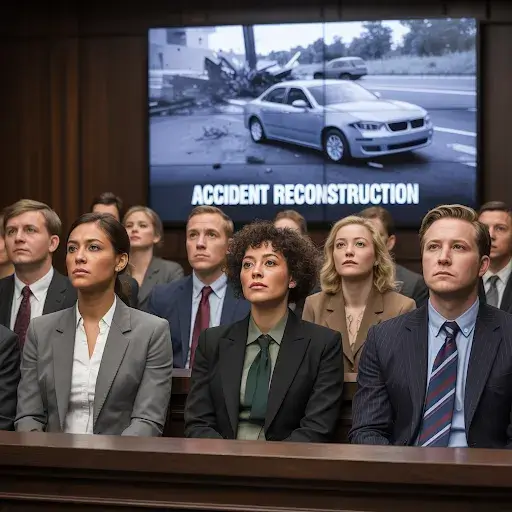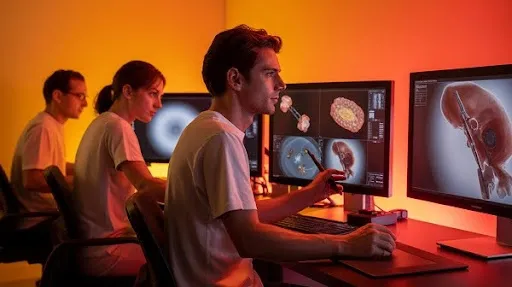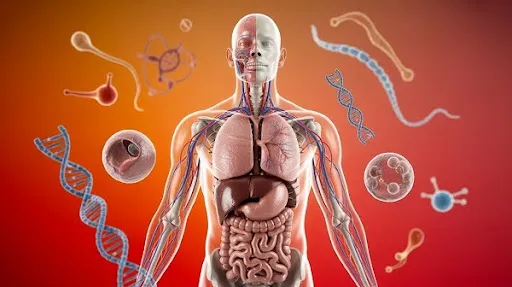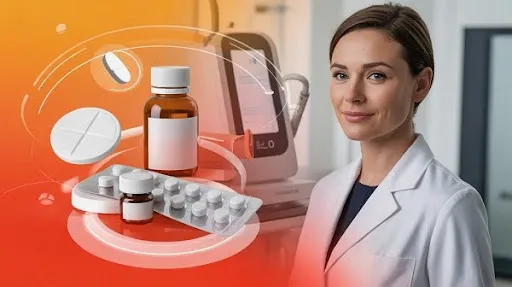A courtroom isn’t a movie theater, but visuals still win.
Jurors are regular people, postal workers, accountants, and schoolteachers. You expect them to grasp the mechanics of a collision, how a machine failed, or why a fall was unavoidable, using only words and a few still photos?
That’s a hard sell.
This is where forensic animation becomes your closer. It transforms complex incidents into crystal-clear visuals. It speaks a universal language: motion, clarity, and fact. It doesn’t replace the evidence; it highlights it. Jurors stop guessing and start understanding.
Attorneys who use forensic animation for legal cases don’t just explain. They show. They persuade. And more often than not, they win.
What Is Forensic Animation and Why Should Lawyers Care?
Understanding Forensic Animation in Simple Terms
Forensic animation means using computer-generated visuals to recreate incidents in civil or criminal cases. Think car crashes, workplace accidents, equipment malfunctions, and even crimes.
A forensic animator takes real data, surveillance footage, eyewitness accounts, and measurements and turns them into a 3D animation that can be played in court or during mediation.
This isn’t science fiction. It’s data visualized. And it can be the single most powerful asset in your legal strategy.
Where Does Forensic Animation Fit in a Legal Case?
- During expert depositions
- At mediation to prompt better settlements
- In court to support testimony
- When evidence is hard to interpret
- When facts are too complex for laypeople
The Tools Behind a Forensic Animation Video
How Forensic 3D Animation Is Actually Made
It starts on-site. Forensic animation companies usually begin by scanning the actual location where the incident occurred.
A 3D laser scanner spins and collects millions of data points, distances, angles, and elevations. These aren’t estimates; they are exact figures.
From this scan, forensic computer animators create digital models of roads, sidewalks, vehicles, machinery, and buildings; all real and all to scale.
Then, they add textures, materials, and lighting, not to dramatize but to clarify. A wet floor looks wet, a rusty machine looks neglected, and an obstructed view becomes obvious.
Finally, the animation is timed and synced with testimonies or footage.
You’re left with a visual reconstruction grounded in forensic science, not guesswork.
Why Not Just Use Photos?
Because photos freeze a moment, they don’t show what happened before or after. They don’t explain motion, speed, visibility, or timing. A forensic animation video does all that, visually, frame by frame, without needing a single word.
The Psychology Behind Legal Animation
People Remember What They See
According to the Cone of Experience theory by Edgar Dale, people remember:
- 10% of what they read
- 20% of what they hear
- 50% of what they see and hear
Forensic science animation boosts retention. It gives jurors and mediators a mental anchor, so they walk into deliberation still seeing your case in their minds.
Emotion Isn’t Always Bad
Forensic animation doesn’t aim to manipulate emotions. But when done well, it can help the jury feel the story, not just hear it. Seeing a human figure fall, or the timeline of a preventable crash, gives weight to testimony in ways words can’t.
Who Uses It, and Why It Pays Off
For Plaintiff Attorneys
3D forensic animation helps plaintiffs:
- Simplify complex expert testimony
- Increase the chance of higher settlement offers
- Show damages, not just describe them
- Strengthen visual storytelling in personal injury and liability claims
For Defense Attorneys
Defense teams use animation to:
- Challenge the plaintiff’s timelines or sequences
- Recreate alternate scenarios based on data
- Support expert testimony with clear visuals
- Show jurors that things were not as cut and dry as claimed
Good animation is objective. It doesn’t argue. It shows.
Real Examples of Where Forensic Animation Works
Personal Injury and Slip & Fall
A grocery store slip. The floor was wet. Was there a warning sign? Was it visible? Did the plaintiff run or walk? Did they notice the spill?
A forensic computer animation can show the actual scene from multiple angles, recreate a witness’s point of view, and even show the timeline from the spill to the fall.
Car Accidents
Speed, angle of impact, weather, brake timing, and visibility are all difficult to explain but easy to show. Car crash animations use ghost vehicles to show what happened versus what should have happened, which is powerful for jurors.
Workplace Accidents
A malfunctioning machine causes injury. Was it maintained? Were guards in place? Was human error involved?
A Forensic Animation Specialist can create a step-by-step animation showing mechanical failures, interactions, and possible errors based on factual data and expert input.
Quick Wins from Using Forensic Animation Services
What you gain when you bring in professionals:
- Clarity in communication
- Speedier settlements
- Increased credibility
- Jury comprehension
- Visual support for expert witnesses
- Less room for opposition to distort facts
This is why more legal teams are bringing in forensic animation companies early in the discovery phase. The earlier you plan, the stronger your visual case.
Forensic Animation Uses Real Evidence
It Starts with the Scene
Before a single frame is animated, forensic animation companies begin with data collection. The site of the incident is scanned using 3D laser technology.
This scanner rotates rapidly, sending out beams and capturing millions of data points, exact distances, shapes, and environmental features.
These raw scans become the digital skeleton for the scene.
Turning Scans Into Stories
Once scanned, the forensic animators use that data to build a 3D environment. Think roads, guardrails, machinery, signage, and even lighting conditions at the time of the event.
They model these based on real specs. CAD files, traffic signal data, weather records, and medical reports all feed into the process.
This is forensic science in legal cases, where every detail is fact-checked and verified before animation begins.
What If the Environment Changed Since the Incident?
You might have had a slip-and-fall six months ago, but the floor layout was changed, or the lighting was upgraded.
That’s not a problem.
Forensic 3D animation can recreate what the site looked like at the time of the event using historical data and on-site evidence.
Animators act like digital time travelers, bringing jurors back to the moment the incident happened, not what the place looks like today.
Reconstructing Reality
From Flat Footage to Full Story
Security camera footage is common, but it’s rarely helpful alone. The angle is off, the resolution is poor, and the subject moves out of frame.
Forensic computer animators can use that limited footage, combine it with laser scans and known measurements, and recreate the same event from multiple viewpoints, including the one the plaintiff or defendant had at the time.
This is particularly valuable when your case depends on what someone could or couldn’t see.
What If You Only Have Partial Video?
It’s still usable. Let’s say you have one camera showing part of a hallway and another camera that picks up the end of the event.
The animation team can stitch those perspectives together, fill in the blanks using measurements, and present the full timeline visually, accurately, and defensibly.
This is how you turn weak footage into strong evidence.
Strategic Use of Forensic Animation for Plaintiff Attorneys
Here’s how forensic animation services are helping plaintiff attorneys settle faster and win stronger.
Reinforce Expert Testimony
Your biomechanical or medical expert may be brilliant, but jurors often lose the plot five minutes into technical testimony. A forensic animation video plays while they speak. It locks in the audience’s attention. It gives the words context.
Create Leverage in Mediation
Showing your animation to the defense during settlement talks is a smart move. If they weren’t expecting it, it may force them to reassess their odds in court.
It’s common for “zero offer” cases to turn into 6- or 7-figure settlements after animation is shown.
Build a Stronger Emotional Impact
You’re not aiming to manipulate, but when jurors see a person fall, get hit, or crushed by faulty machinery, they connect more deeply with the case. A well-made forensic science animation helps the facts hit harder.
Using Forensic Animation on the Defense Side
Don’t think this is just a tool for plaintiffs.
Defense attorneys use forensic animation for legal cases just as effectively, sometimes more so.
Challenge the Plaintiff’s Version
Animation gives defense teams the ability to present an alternate version of events, still grounded in evidence but with a new lens.
It can show that timing didn’t allow for avoidance or that claimed injuries don’t match the mechanics of impact.
Support Your Expert
Just like plaintiffs, defense experts can benefit from visual aids. The jury may doubt what they say if it sounds too abstract. Showing how a machine worked, how a driver reacted, or what someone could realistically see helps neutralize skepticism.
Reduce Emotional Bias
Graphic injuries or emotional testimony can sway juries. A clean, clear forensic computer animation focuses on facts. It helps jurors see the situation without being overwhelmed by dramatic details.
Forensic Animation in Insurance and Corporate Defense
Insurance companies and large corporations hire forensic animation specialists proactively, not reactively.
Why?
Because animations:
- Help clarify liability
- Show events from multiple viewpoints
- Highlight safety protocol compliance
- Diminish jury confusion
Especially Useful In:
- Auto claims
- Workers’ comp disputes
- Product liability defense
- Construction site accidents
Animations don’t only protect defendants. They protect the truth.
Forensic Animation FAQs Answered
Is Forensic Animation Admissible in Court?
Yes, most courts accept forensic animations as demonstrative evidence. The key is to ensure that the animation is grounded in real data, such as expert testimony, physical evidence, measurements, and site documentation. Judges typically review these animations before trial.
Does Animation Count as Evidence?
No, it supplements the evidence. It illustrates what the evidence suggests, helping jurors understand the case better, but the animation itself doesn’t prove anything independently.
Can Animation Replace Witnesses?
No. It supports them. Your animation should back up what your expert says, not vice versa.
What Makes a Good Forensic Animation Company?
- Legal experience
- Data-driven process
- The team includes engineers and animators
- Willingness to collaborate with attorneys and experts
- Transparent about admissibility limits
Prolific Studio checks all those boxes.
When Is the Best Time to Involve an Animation Studio?
Right after discovery. Waiting until the last minute limits your options. You want your forensic animation video ready for mediation, deposition, and if needed, trial. You also want enough time to let experts review and approve it.
Last-minute animations feel rushed. Early ones feel strategic.
Bullet Point Recap: Why Forensic Animation Is Worth It
Here’s what you gain when you bring in forensic animation early:
- A clearer way to present complex facts
- Stronger expert testimony
- Easier jury retention
- Higher settlement leverage
- Control over how your evidence is interpreted
- Greater overall confidence in your case
Different Types of Legal Exhibits That Benefit From Forensic Animation
Not every case is about a crash or a fall. Attorneys use forensic animation across different exhibit types to highlight alternative scenarios, environmental changes, and perspective-based clarity. Here’s how those come into play.
“What Could Have Happened” Scenarios
Also called “Could Have, Should Have, Would Have” exhibits.
Let’s say your case involves a pedestrian struck while crossing a road. The plaintiff claims the light was green. The defense says it wasn’t. Using 3D forensic animation, your team can simulate different conditions:
- What if the driver had braked earlier?
- What if the pedestrian waited a few seconds longer?
- What if signage or visibility were different?
These scenarios help the jury visualize how outcomes might have changed under different but plausible actions, without straying from the core facts.
Cases Where the Environment Has Changed
Maybe the store was remodeled, the tree that blocked visibility was cut down, or the sidewalk that caused a trip was repaired before inspection.
Forensic animation companies can reconstruct the original layout using:
- Historical photos
- Blueprints
- Satellite data
- Testimony
- Site scan data (if available)
This is where forensic science animation earns its place. It acts like a visual time machine, bringing jurors back to a version of the scene that no longer exists.
Perspective Exhibits: “What They Saw”
Often, the heart of a case depends on what someone could or couldn’t see.
Was the stop sign visible from the driver’s seat? Could the worker see the machine jam? Did the guard have a clear line of sight?
These perspectives allow the jury to “sit” in the driver’s seat or look from the bystander’s viewpoint. A forensic computer animation can use real camera angles, sightlines, and lighting to demonstrate visibility and timing with surgical precision.
These aren’t guesses. These are reconstructions grounded in physics and data.
Why Jurors Trust Forensic Animation
It Shows, Not Tells
Jurors are bombarded with testimony, legal language, and objections all day. It’s dense and abstract. But a forensic animation video speaks clearly—no legalese required.
It’s a break from confusion.
It builds trust. They see the information for themselves, process it at their own pace, and connect the dots without being told how to think.
It Reduces Assumptions
When you rely only on testimony and exhibits, you leave space for interpretation, especially when jurors have to imagine the scene. With a 3D forensic animation, there’s less room for mental error.
It also removes the emotional fog from photos of injuries or distressing video footage. A clean, data-focused animation can show the same without shock value.
What to Know Before Hiring Forensic Animation Specialists
Not all studios are ready for trial. Before you bring one into your case, ask these questions:
- Have they worked on legal cases before?
- Can they collaborate with your experts?
- Do they offer revisions based on court feedback?
- Are they familiar with admissibility standards?
- Can they clearly explain their process and tools?
Prolific Studio does all this, and more. We’re an animation studio in Chicago with experience across dozens of legal industries, from product liability to car crashes to civil rights cases.
How Long Does Forensic Animation Take?
Timelines vary. A simple animation with existing site scans and known variables might take two weeks. More complex cases, or those needing original scans and multiple iterations, could take a month or more.
The earlier you plan for it, the smoother the integration into your legal strategy.
Animations aren’t just a “nice-to-have.” They’re a critical part of the preparation process now. Firms that wait until trial week are usually scrambling. Don’t be that firm.
Case Outcomes Driven by Visuals
Attorneys across the country are reporting huge outcomes when using animation:
- A zero-offer case that turned into a $5.5 million settlement, on day one of trial.
- A complex product liability claim where animation clarified manufacturing errors, but no photos could.
- A wrongful death case was settled in mediation after showing a timeline animation synced with the 911 call audio.
These aren’t outliers. This is what happens when jurors understand the evidence.
How Forensic Animation Helps Win Personal Injury Cases
Personal injury claims often hinge on medical understanding, cause and effect, and demonstrable negligence. But the reality is, words fall short.
Injury animation fills that gap.
You can:
- Recreate body movement and impact
- Show the timing between actions
- Align medical scans with animated surgery or treatment steps
- Clarify biomechanics and pain mechanics
A forensic animation video connects those dots visually, even if you already use MRI images or X-rays. You’re giving the jury the complete picture.
Are These Animations Evidence?
No, and that’s a good thing.
Forensic computer animation is a visual aid, not new evidence. That means you’re not introducing something that needs its chain of custody or verification process. Instead, it supports the interpretation of evidence you already have.
This also means the admissibility bar is often easier to meet, especially if all experts agree the animation is accurate.
Ready to Use Forensic Animation in Your Case?
You’ve read the stats. You’ve seen the use cases. You understand the process.
Now ask yourself:
- Are your jurors visual learners?
- Is your case complex?
- Will expert testimony benefit from animation?
- Are your facts hard to visualize?
Then, it’s time to hire forensic animation services from a trusted team that knows what works in court.
Why Prolific Studio?
Prolific Studio combines technical skill with legal understanding. We don’t just create visuals. We partner with attorneys to build forensic animations that hold up in court, help settle cases faster, and leave a lasting impression on jurors.
Our animators, engineers, and visual experts collaborate with your experts to make sure every frame is defensible, clear, and compelling.
From high-stakes injury cases to complex construction disputes, we’ve helped hundreds of legal professionals tell their story better.
If you’re serious about winning your case or raising your client’s settlement value, don’t wait.
Reach out to our team today. Let’s talk about what your case needs.
Final Thought
The justice system rewards clarity. It rewards preparation. It rewards teams who can show, not just say, what happened.
Forensic animation is no longer a luxury tool. It’s a courtroom essential.
Bring in the visuals. Win with confidence.

